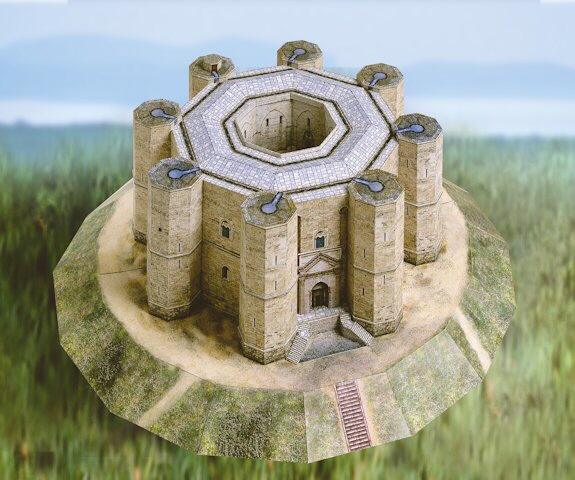Castel del Monte

scale 1:250
length 35 cm
width 35 cm
height 12 cm
degree of difficulty 1
number of sheets 6
Castel del Monte
Emperor Friedrich II von Hohenstaufen had the Castel del Monte built in Apulia in the southeast of Italy. He ordered its construction in 1240. Since then the Castel has thrilled countless people and not without reason has it been called the "Crown of Apulia".
Who was this emperor? The Swabian Staufer lineage had extended its rule to southern Italy through marriages, and it was there that Friedrich II spent the largest part of his reign. Many of his reforms actually seem modern: improvements in the health system, laws against torture and against pollution, the promotion of the sciences and poetry. His book about ornithology and hunting with falcons is famous. But with him there is also an indication of the later absolutist state. He loved the splendour of a powerful ruler. He made a great impression at the Imperial Diet in Ravenna, when he led elephants, camels, lions, panthers, falcons and owls in his entourage.
But whatever specific aim he followed with the Castel del Monte has remained controversial and unclear. Is it a castle or a fortress? It has neither arrow slits nor drawbridges. It has no moat, nor has it sally ports. Did it only serve for prestige? The entrance portal and the windows are certainly extremely decorative. Or is it a building with mysterious symbolism?
Intensive surveys and esoteric interpretations have led to adventurous theories. One thing is certain, that the octagonal construction possesses an obvious symbolic power. The exterior façade, the inner courtyard and the eight bastions at the eight corners are all octagonal. There is no clear example among other earlier castles for this octagon with its many axes of symmetry. However, it does remind one of the octagonal "Pfalzkapelle" (palace chapel) in Aachen, where the crowning of the German kings took place, and it reminds one of the octagonal imperial crown. Is the Castel therefore meant to reflect the ideal of the Empire?
But no matter how unique this architectural monument of the Middle Ages was, over the centuries it deteriorated more and more, and restoration work only took place in the 20th century. Since 1996, it now belongs to the World Cultural Heritage of UNESCO.
